🍱 Animal Nutrition
Ration, Types and it's constituents
Which of the following statment is correct?
- Nutrition involves various chemical reaction and physiological process which transforms Food into body tissue ( milk, meat, egg, wool )and activities (Work power).
- Nutrition involves ingestion, digestion, and absorption of the various Nutrients and their transport to all the body cell and the removal of unusable elements and waste products of Metabolism.
- There are two aspects in Animal Nutrition
- Science of Nutrition – It is the work of Animal Nutritionist.
- Art of feeding of animals.- Good stockman ship.
Balance Ration
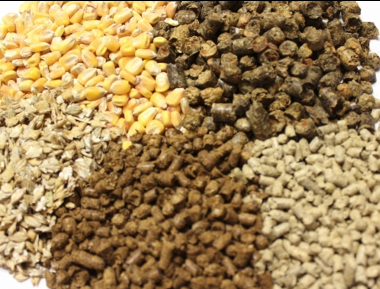
- A balance ration is a ration which provides all the essential nutrients to the animal in such proportion and amounts that are required for the proper nourishment of the particular animal in 24 hours (One Day).
- Also known as daily ration or simply as ration.
- The ration is fed at the rate of 2 to 2.5 % of body weight each day.
Ration Constituents


- Concentrates: Feeds that contain less than 18% crude fiber are called concentrates such as grains, oilcakes, grain by products etc.
- Roughage: Feeds that contain more than 18% crude fiber are called roughage such as hay, silage, fodder etc.

- Pasture: Fodder crops grown on the land for grazing animals.
- Hay: Hay is grass that is cut,
driedand stored by humans to be used in future. It is characterized by having low moisture content (less than 16%). - Silage: Green grass is a good source of vitamin A which is present in the form of Carotene.
Green foddercan be preserved as silage stored for long period (up to months). Silage is a type of fodder made from green foliage crops which have been preserved by fermentation to the point of acidification. Silage has 65-70% moisture content. - Ensiling:
Process of making silage. In the ensiling process, the absence of oxygen leads to the fermentation of water-soluble carbohydrates to produce organic acids which increase acidity of the material (pH about 4.0). - Energy feeds: Feeds containing less than 20% crude protein are called energy feeds.
- Protein supplements: Feeds that contain 20% or more protein are called protein supplements.
Importance of drinking water for dairy animals
- Ad libitum basis (as and when required on free choice basis)
- Normally, an adult healthy animal require 75 to 80 litres of water daily. Since milk contains about 85% water, for every litre of milk produced, additional two and half litres water is required.
- During summer, crossbred cows and buffaloes should be given bath twice daily and at least 100 litres of water per day to manage heat.
- Salinity of water is seldom a problem in dairy buffalo feeding. A salt content of up to 5 g/litre of water can be used for buffaloes.
Types of Ration
Maintenance Ration
- A ration given daily to the animal to maintain in resting non-production condition with good health.
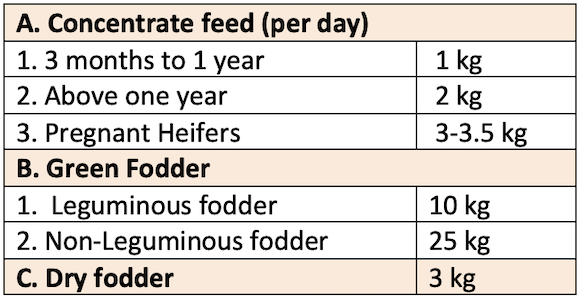
Production Ration
- A portion of the ration given daily is more than maintenance requirement for purpose of growth, production, and work.
Flushing
- This is a temporary but purposeful increase in nutrition/ feed around breeding time.
- Its objective is to boost ovulation, conception, and embryo implantation rates. Flushing may also increase the proportion of females that exhibit estrus.
Steaming up
- Steaming up refers to providing extra concentrate to a pregnant heifer in the last 4 weeks of pregnancy.
- It provides extra nutrients for the animal and the growing foetus.
- Steaming up also allows the heifer to put on extra weight (reserve energy) to promote maximum milk production from the very beginning of the lactation.
Calf starter
- Concentrate feed offered to the young calves after 2 weeks of age.
Challenge feeding
- The practice of feeding higher levels of concentrate to challenge the cow to reach her maximum milk production.
Creep feeding
- The place of feeding lamb, calves and piglet means only young animals but
not adults. - Creep feeding is a method of supplementing the diet of young livestock, primarily in beef calves, by offering feed to animals who are still nursing.
- Creep feed is sometimes offered to swine, and it is possible with companion grazing animals such as sheep and goats.
- ‘Creep Feeding’, the practice of offering grain to lambs/kids that have not yet been weaned, can help the eventual transition off of milk to a post-weaning diet and can reduce stress at weaning time.
Rumen Health
- Anorexia is lack of appetite.
- Percentage utilization of protein within animal body denotes it’s
biological value. Sodium deficiencyin cattles caused dehydration (loss of fluids.)Tympanitisis the disorder in cattles caused by excessive feeding of lush green fodders.- Ca deficiency causes Milk fever in dairy cattles.
- Fe deficiency causes Anaemia.
- P deficiency causes Pica disease.
Teeth in Cattles
- Cattle first develop 20 temporary teeth, known also as deciduous, milk, or baby teeth. These temporary teeth eventually fall out and are replaced with
32 permanentor adult teeth as an animal matures. - Dentition Formula (ICPM: Incisor, Canaion, Premolars, Molars - pairs)
- Temporary dentition (20): 0/4 0/0 3/3 0/0
- Permanent dentition (32): 0/4 0/0 3/3 3/3
- Number of permanent cheek teeth in cow (molar + premolar) =
24. - Molar teeth do not emerge temporarily in cows and buffaloes. They come straight out permanent.
- Canine teeth are not found in ruminant animals.
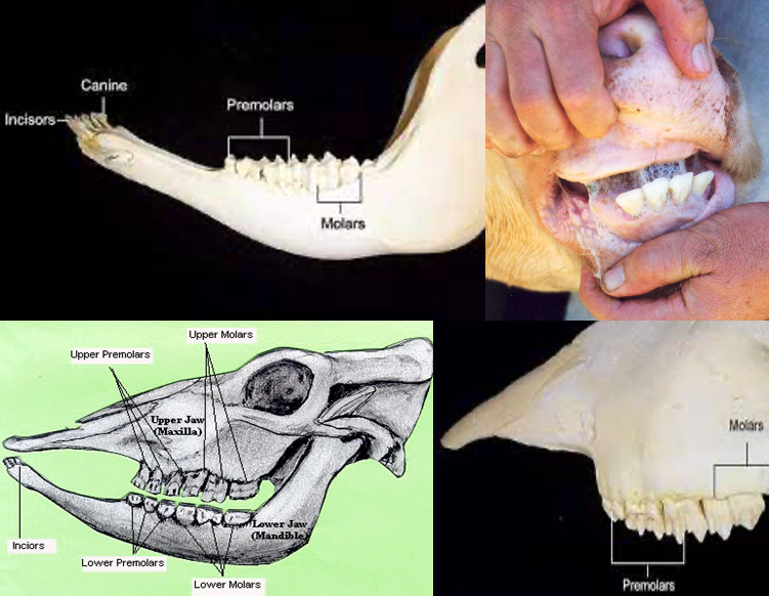
Parts of Stomach in Ruminants
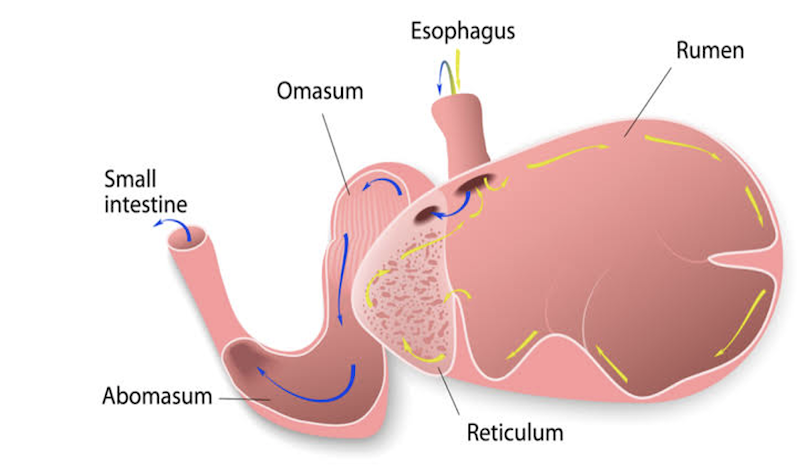
- The stomach of a ruminant has
four chambers. - The first chamber is the largest and is called the
rumen. - The second chamber is the reticulum (honeycomb).
- The third is the Omasum (book) and the fourth is the
abomasum(thetrue stomach). - The ruminant chews grass and shallows and it goes into the rumen.
- When the ruminant has finished eating, the food is brought back up and rechewed. This is called chewing the cud or rumination. If the animal stops ruminating this is a sign of ill health.
Cattle,Goats,Sheep,BuffaloandCamelchew the cud. They areruminants. They chew the cud (ruminate) for 6 to 8 hours each day.- The horse, donkey and mule are herbivores but do not chew the cud. They are
non-ruminants.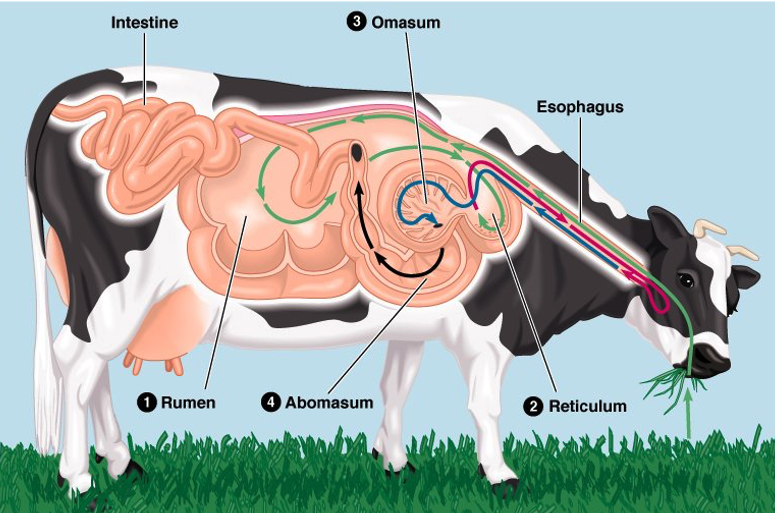
Explore More 🔭
🟢 https://www.youtube.com/watch?v=CJomFwt3eMs
References
- G.C. Banerjee: A Textbook of Animal Husbandry
- https://www.dairyknowledge.in
- https://buffalopedianew.cirb.res.in/godavari/
- https://nbagr.icar.gov.in/
- https://www.nddb.coop/
- Wikipedia
Which of the following statment is correct?
- Nutrition involves various chemical reaction and physiological process which transforms Food into body tissue ( milk, meat, egg, wool )and activities (Work power).
- Nutrition involves ingestion, digestion, and absorption of the various Nutrients and their transport to all the body cell and the removal of unusable elements and waste products of Metabolism.
- There are two aspects in Animal Nutrition
- Science of Nutrition – It is the work of Animal Nutritionist.
- Art of feeding of animals.- Good stockman ship.
Balance Ration

- A balance ration is a ration which provides all the essential nutrients to the animal in such proportion and amounts that are required for the proper nourishment of the particular animal in 24 hours (One Day).
- Also …
Become Successful With AgriDots
Learn the essential skills for getting a seat in the Exam with
🦄 You are a pro member!
Only use this page if purchasing a gift or enterprise account
Plan
Rs
- Unlimited access to PRO courses
- Quizzes with hand-picked meme prizes
- Invite to private Discord chat
- Free Sticker emailed
Lifetime
Rs
1,499
once
- All PRO-tier benefits
- Single payment, lifetime access
- 4,200 bonus xp points
- Next Level
T-shirt shipped worldwide

Yo! You just found a 20% discount using 👉 EASTEREGG

High-quality fitted cotton shirt produced by Next Level Apparel